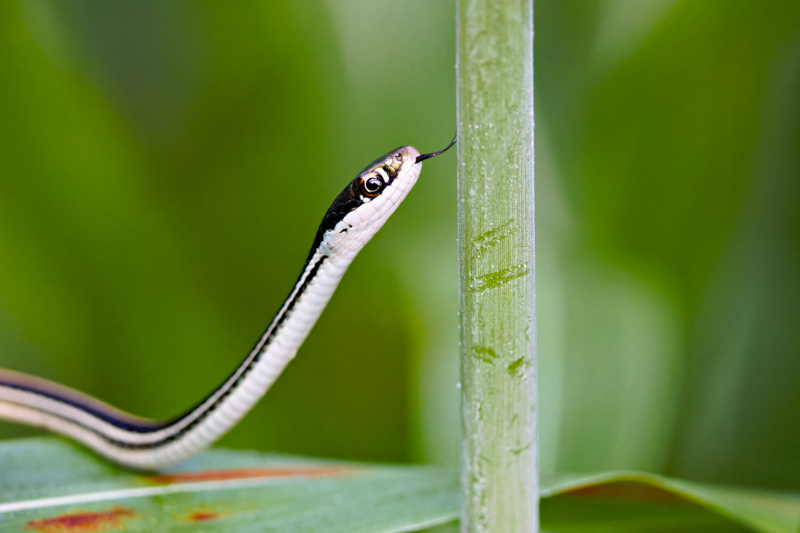A couple of days ago, I had an intriguing experience at the Sequoyah National Wildlife Refuge in Oklahoma. As I was exploring a dense, vegetation-rich area, I noticed a Western Ribbon Snake leisurely making its way through the grass. To my surprise, a Green Tree Frog was sitting nearby on a leaf. Naturally, I wondered if the snake would attempt to make a meal out of the frog. I held my breath and watched the scene unfold.

The Ribbon Snake edged closer, flicking its tongue to gather chemical cues from the air, seemingly sizing up the frog. Just as I thought I might witness a dramatic predator-prey interaction, the snake turned away and continued on its path, leaving the frog untouched. While part of me was a bit disappointed to miss out on capturing a predatory moment, I was nonetheless thrilled to observe the Ribbon Snake’s graceful movement through the wild grasses and foliage.

The Fascinating Western Ribbon Snake
The Western Ribbon Snake (Thamnophis proximus) is a captivating species with several distinctive traits and behaviors that make it stand out.
Physical Characteristics
- Distinctive Stripes: This snake features three prominent light-colored stripes running the length of its body. The mid-dorsal stripe, often yellow or orange, contrasts sharply with its dark brown or black body.
- Size: Adults typically range from 18 to 36 inches in length but can grow up to nearly 40 inches. Their tails are notably long, making up about one-third of their total body length.
- Head and Scales: The Western Ribbon Snake has a head wider than its slender neck, keeled scales, and round pupils. The scales along the upper jaw are white with no markings, and there’s a distinct vertical white bar in front of the eye.
Habitat and Behavior
- Semi-Aquatic Lifestyle: These snakes are commonly found near water bodies such as streams, ponds, and lakes. They are adept swimmers and will dive into water if threatened, using dense vegetation for cover.
- Activity Patterns: Western Ribbon Snakes are diurnal, meaning they are most active during the day. They prefer warmer temperatures but can be active in a range from 39 to 107 degrees Fahrenheit, with an optimal range of 72-79 degrees Fahrenheit.
- Reproduction: Mating occurs in early spring, and females give birth to live young in late summer, producing between 5 to 25 offspring per litter.
Diet and Predation
- Diet: Their diet primarily consists of amphibians, including frogs and tadpoles, but they also eat small fish. Juveniles often feed on Blanchard’s cricket frogs found in low grass around ponds.
- Predators: Young ribbon snakes are preyed upon by bullfrogs, birds, and large fish.
Adaptations and Defense
- Camouflage and Escape: Their body coloration provides effective camouflage in their natural habitat. When disturbed, they can quickly dive into water or hide in thick brush or crevices.
- Non-Venomous: While they are non-venomous and harmless to humans, their saliva has been reported to have mild toxic properties, though it is not dangerous to humans.
Distinguishing Features
- Comparison with Eastern Ribbon Snake: The Western Ribbon Snake can be distinguished from the Eastern Ribbon Snake by the absence or reduction of a broad, brown ventro-lateral stripe, and by its larger paired parietal spots, longer muzzle, and tail.

Witnessing the natural behavior of the Western Ribbon Snake was a reminder of the intricate and often surprising interactions within the wild. Whether you’re a fellow wildlife enthusiast or just someone with a keen interest in nature, the Sequoyah National Wildlife Refuge offers countless opportunities to observe and appreciate such fascinating creatures.
For more information, you can check out iNaturalist’s guide.
